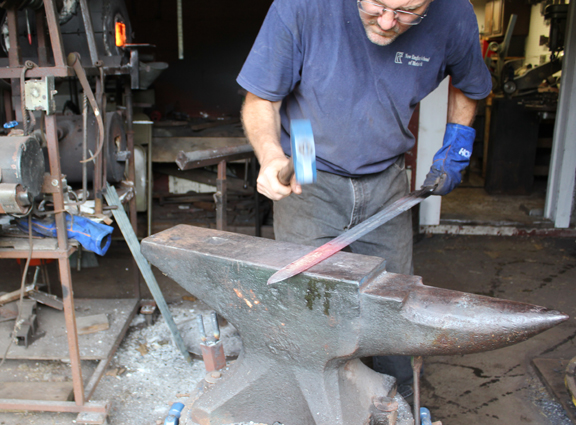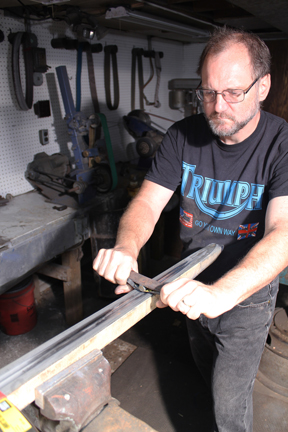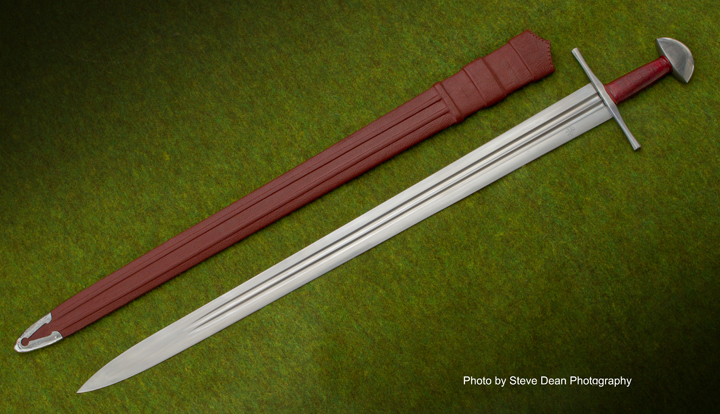Kevin R. Cashen
Super Moderator
The medieval sword found in the river Witham is one of the most recognizable treasures at the British museum: http://www.britishmuseum.org/resear...spx?assetId=296785001&objectId=36133&partId=1
A few years ago I had the rare privilege of spending an afternoon measuring and studying it first hand, and I had a feeling then that it was something special. Recently a good customer got his turn at having me make something and asked if there was something I would like to do (as I said, he is a good customer). This was my opportunity to try my hand at the Witham and get paid for doing it, so when he said that he loved that sword the fun began! I always thought that the original’s gaudy inscriptions were a distraction from its phenomenal lines and proportions, and so when I suggested that we go with a cleaner and more weapon-like version, my customer was on board and even suggested a brazil nut pommel to keep with the theme. This was going to be fun since it would also test my skills at redesigning what was perhaps a perfect medieval weapon with a slightly different hilt and pommel while still keeping the same flawless dynamics of balance points and center of percussion etc…



There was no decision to be made regarding blade material, it would, of course be my trade mark Crucible formula L6. But I found one of the biggest challenges of this blade immediately in the forging process- those narrow double fullers. I forged two blades to get the proportions of those grooves right and discovered a nasty twist that they gave to the process, and I say “twist” not just metaphorically! Those fullers acted like two “I” beams running down the blade causing any subtle strain imbalance to pull the blade in every crooked direction possible. It took longer to normalize the blade than it did to forge it, and the heating and cooling had to be exact.

But once forged, grinding the blade was a pleasure, it always is when doing these exact recreations because you can feel the blade come alive in your hands as you shave off each thousandth of an inch closer to the original. I knew that the tapers and cross sections of this blade were something unique, but I was not prepared for the feel of it in the hand. I have worked with many really effective weapons that were the Hot Rod Fords or Chevy’s of their time, but the Witham is a Ferrari! Point tracking is so dead on that if a trained knight aimed it at you, your earthly affairs had better be in order, and yet this quick blade would cut like a laser.

Polishing was not too bad either, since the planes of the blade were all broken down into convenient narrow sections that gave up their scratches in short order. And those fullers reflected the light in a way that created great lines and almost Art Deco sleekness to the blade; I was so glad we didn’t go with the inlayed inscriptions.
For the cross and pommel we chose wrought iron, which completed the battlefield workhorse theme. The scabbard was tradition wood wrapped in a maroon goatskin bookbinding leather from a new supplier that I like. The chape took longer to make than the entire scabbard, since I hammered it out of sheet steel. Normally I would use non-ferrous, which raises and domes quite easily, the steel was much more ornery and required a bit more hot work, but in the end the hammered finish of the steel went well with the overall theme.

A few years ago I had the rare privilege of spending an afternoon measuring and studying it first hand, and I had a feeling then that it was something special. Recently a good customer got his turn at having me make something and asked if there was something I would like to do (as I said, he is a good customer). This was my opportunity to try my hand at the Witham and get paid for doing it, so when he said that he loved that sword the fun began! I always thought that the original’s gaudy inscriptions were a distraction from its phenomenal lines and proportions, and so when I suggested that we go with a cleaner and more weapon-like version, my customer was on board and even suggested a brazil nut pommel to keep with the theme. This was going to be fun since it would also test my skills at redesigning what was perhaps a perfect medieval weapon with a slightly different hilt and pommel while still keeping the same flawless dynamics of balance points and center of percussion etc…



There was no decision to be made regarding blade material, it would, of course be my trade mark Crucible formula L6. But I found one of the biggest challenges of this blade immediately in the forging process- those narrow double fullers. I forged two blades to get the proportions of those grooves right and discovered a nasty twist that they gave to the process, and I say “twist” not just metaphorically! Those fullers acted like two “I” beams running down the blade causing any subtle strain imbalance to pull the blade in every crooked direction possible. It took longer to normalize the blade than it did to forge it, and the heating and cooling had to be exact.

But once forged, grinding the blade was a pleasure, it always is when doing these exact recreations because you can feel the blade come alive in your hands as you shave off each thousandth of an inch closer to the original. I knew that the tapers and cross sections of this blade were something unique, but I was not prepared for the feel of it in the hand. I have worked with many really effective weapons that were the Hot Rod Fords or Chevy’s of their time, but the Witham is a Ferrari! Point tracking is so dead on that if a trained knight aimed it at you, your earthly affairs had better be in order, and yet this quick blade would cut like a laser.

Polishing was not too bad either, since the planes of the blade were all broken down into convenient narrow sections that gave up their scratches in short order. And those fullers reflected the light in a way that created great lines and almost Art Deco sleekness to the blade; I was so glad we didn’t go with the inlayed inscriptions.
For the cross and pommel we chose wrought iron, which completed the battlefield workhorse theme. The scabbard was tradition wood wrapped in a maroon goatskin bookbinding leather from a new supplier that I like. The chape took longer to make than the entire scabbard, since I hammered it out of sheet steel. Normally I would use non-ferrous, which raises and domes quite easily, the steel was much more ornery and required a bit more hot work, but in the end the hammered finish of the steel went well with the overall theme.

Last edited:
